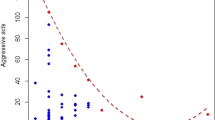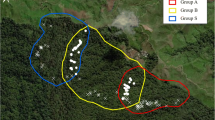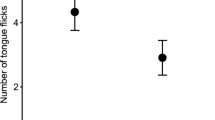Abstract
Long-term monogamy is a key characteristic of family living across animals. The evolutionary maintenance of long-term monogamy has been suggested to be facilitated by increased reproductive coordination as a result of mate familiarity, leading to increased reproductive success. However, such effects can be compromised if females mate outside the pair bond (e.g. female polyandry), introducing conflicts of interest between the male and female. Here, we experimentally test the effects of both mate familiarity and female polyandry on agonistic behaviour and reproduction in a family living lizard, Liopholis whitii. We found that mate familiarity did not decrease the level of aggression between pairs whereas reducing female polyandry did. However, we did not find an effect of either mate familiarity or female polyandry on female reproductive output. These results suggest that male behavioural responses to female polyandry may influence pair stability in Liopholis whitii, providing support for the growing appreciation of the multiple ways in which female polyandry can influence the stability of family living.
Significance statement
Family living is underpinned by social pair bonds between adults (i.e. stable social monogamy). Therefore, key to understanding the emergence and maintenance of family living is identifying factors influencing pair bonds. We manipulated both female polyandry and mate familiarly in replicated enclosure experiment using social lizards to test their role in mediating within-pair aggression and ultimately the coordination of reproductive behaviour and hence reproductive output. We found that polyandry but not mate familiarity influenced levels of aggression between pairs but this did not transmit into concomitant effects on reproductive output.

Similar content being viewed by others
References
Adkins-Regan E, Tomaszycki M (2007) Monogamy on the fast track. Biol Lett 3:617–619
Bates D, Maechler M, Bolker B, Walker S, Christensen RHB, Singmann H, Dai B, Grothendieck G, Green P, Bolker MB (2016) Package ‘lme4’. https://cran.r-project.org/web/packages/lme4/lme4.pdf
Black JM (1996) Introduction: pair bonds and partnerships. In: Black JM (ed) Partnerships in birds: the study of monogamy. Oxford University Press, Oxford, pp 3–20
Black JM (2001) Fitness consequences of long-term pair bonds in barnacle geese: monogamy in the extreme. Behav Ecol 12:640–645
Bolker BM, Brooks ME, Clark CJ, Geange SW, Poulsen JR, Stevens MHH, White J-SS (2009) Generalized linear mixed models: a practical guide for ecology and evolution. Trends Ecol Evol 24:127–135
Bordogna G, Cunningham GC, Fitzpatrick FJ, Halliwell B, MacGregor HEA, Munch KL, Wapstra E, While GMW (2016) An experimental test of relatedness-based mate discrimination in a social lizard. Behav Ecol Sociobiol 70:2139–2147
Bull CM (1988) Mate fidelity in an Australian lizard Trachydosaurus rugosus. Behav Ecol Sociobiol 23:45–49
Bull CM (2000) Monogamy in lizards. Behav Process 51:7–20
Chapple DG (2003) Ecology, life-history, and behavior in the Australian Scincid genus Egernia, with comments on the evolution of complex sociality in lizards. Herpetol Monogr 17:145–180
Chapple DG, Keogh JS (2005) Complex mating system and dispersal patterns in a social lizard, Egernia whitii. Mol Ecol 14:1215–1227
Chapple DG, Keogh JS (2006) Group structure and stability in social aggregations of white’s skink, Egernia whitii. Ethology 112:247–257
Choudhury S (1995) Divorce in birds: a review of the hypotheses. Anim Behav 50:413–429
Cogger H (2014) Reptiles and amphibians of Australia, 7th edn. CSIRO Publishing, Melbourne
Cornwallis CK, West SA, Davis KE, Griffin AS (2010) Promiscuity and the evolutionary transition to complex societies. Nature 466:969–972
Fox J, Weisberg S (2011) An {R} companion to applied regression, 2nd edn. Sage Publications, Thousand Oaks
Gardner MG, Cooper SJB, Bull CM, Grant WN (1999) Isolation of microsatellite loci from a social lizard, Egernia stokesii, using a modified enrichment procedure. J Hered 90:301–304
Gardner MG, Bull CM, Cooper SJB (2002) High levels of genetic monogamy in the group-living Australian lizard Egernia stokesii. Mol Ecol 11:1787–1794
Gardner MG, Pearson SK, Johnston GR, Schwarz MP (2015) Group living in squamate reptiles: a review of evidence for stable aggregations. Biol Rev 91:925–936
Green AJ (2001) Mass/length residuals: measures of body condition or generators of spurious results? Ecology 82:1473–1483
Griffin AS, Alonzo SH, Cornwallis CK (2013) Why do cuckolded males provide paternal care? PLoS Biol 11:e1001520
Griggio M, Hoi H (2011) An experiment on the function of the long-term pair bond period in the socially monogamous bearded reedling. Anim Behav 82:1329–1335
Halliwell B, Uller T, Wapstra E, While GM (2017) Resource distribution mediates social and mating behavior in a family living lizard. Behav Ecol 28:145–153
Johnstone RA, Keller L (2000) How males can gain by harming their mates: sexual conflict, seminal toxins, and the cost of mating. Am Nat 156:368–377
Kaufman AB, Rosenthal R (2009) Can you believe my eyes? The importance of interobserver reliability statistics in obserations of animal behaviour. Anim Behav 78:1487–1491
Kokko H (1999) Cuckoldry and the stability of biparental care. Ecol Lett 2:247–255
Langkilde T, Lance VA, Shine R (2005) Ecological consequences of agonistic interactions in lizards. Ecology 86:1650–1659
Le Galliard JF, Fitze PS, Ferriere R, Clobert J (2005) Sex ratio bias, male aggression, and population collapse in lizards. Proc Natl Acad Sci USA 102:18231–18236
Leu ST, Burzacott D, Whiting MJ, Bull CM (2015) Mate familiarity affects pairing behaviour in a long-term monogamous lizard: evidence from detailed bio-logging and a 31-year field study. Ethology 121:760–768
Marshall TC, Slate J, Kruuk LEB, Pemberton JM (1998) Statistical confidence for likelihood-based paternity inference in natural populations. Mol Ecol 7:639–655
McEvoy J, While GM, Sinn DL, Wapstra E (2013) The role of size and aggression in intrasexual male competition in a social lizard species, Egernia whitii. Behav Ecol Sociobiol 67:79–90
O’Connor DE, Shine R (2004) Parental care protects against infanticide in the lizard Egernia saxatilis (Scincidae). Anim Behav 68:1361–1369
Olsson M, Madsen T, Ujvari B, Wapstra E (2004) Fecundity and MHC affects ejaculation tactics and paternity bias in sand lizards. Evolution 58:906–909
Osorio-Beristain H, Drummond H (2001) Male boobies expel eggs when paternity is in doubt. Behav Ecol 12:16–21
Pyle P, Sydeman WJ, Hester M (2001) Effects of age, breeding experience, mate fidelity and site fidelity on breeding performance in a declining population of Cassin’s auklets. J Anim Ecol 70:1088–1097
R Development Core Team (2015) R: A language and environment for statistical computing. R Foundation for Statistical Computing, Vienna, http://www.R-project.org/
Reichard UH, Boesch C (2003) Monogamy: mating strategies and partnerships in birds, humans and other mammals. Cambridge University Press, Cambridge
Robertson RJ (1990) Tactics and counter-tactics of sexually selected infanticide in tree swallows. In: Blondel J, Gosler A, Lebreton JD, McCleery R (eds) Population biology of passerine birds: an integrated approach. Springer, Berlin, pp 381–390
Sánchez-Macouzet O, Rodríguez C, Drummond H (2014) Better stay together: pair bond duration increases individual fitness independent of age-related variation. Proc R Soc B 281:20132843
Shine R (1980) “Costs” of reproduction in reptiles. Oecologia 46:92–100
Taylor ML, Price TA, Wedell N (2014) Polyandry in nature: a global analysis. Trends Ecol Evol 29:376–383
Valera F, Hoi H, Krištín A (2003) Male shrikes punish unfaithful females. Behav Ecol 14:403–408
van de Pol M, Heg D, Bruinzeel LW, Kuijper B, Verhulst S (2006) Experimental evidence for a causal effect of pair-bond duration on reproductive performance in oystercatchers (Haematopus ostralegus). Behav Ecol 17:982–991
While GM, Uller T, Wapstra E (2009a) Family conflict and the evolution of sociality in reptiles. Behav Ecol 20:245–250
While GM, Uller T, Wapstra E (2009b) Within-population variation in social strategies characterize the social and mating system of an Australian lizard, Egernia whitii. Aust Ecol 34:938–949
While GM, Uller T, Wapstra E (2011) Variation in social organization influences the opportunity for sexual selection in a social lizard. Mol Ecol 20:844–852
While GM, Uller T, Bordogna G, Wapstra E (2014) Promiscuity resolves constraints on social mate choice imposed by population viscosity. Mol Ecol 23:721–732
While GM, Chapple DG, Gardner MG, Uller T, Whiting MJ (2015) Egernia lizards. Curr Biol 25:R593–R595
Wilson S, Swan G (2013) Complete guide to reptiles of Australia, 4th edn. New Holland, Sydney
Acknowledgements
We thank two anonymous reviewers for insightful comments on earlier versions of the MS.
Author information
Authors and Affiliations
Corresponding author
Ethics declarations
Funding
The work was funded by the Australian Research Council (DP150102900 to GMW, TU, DGC and MGG and DE150100336 awarded to GMW) and the Holsworth Wildlife Research Fund (to TBJ).
Conflict of interest
The authors declare that they have no conflict of interest.
Ethical approval
All work was carried out with approval from the Animal Ethics Committee at the University of Tasmania (Ethics Approval Number A0015058).
Data availability statement
All data associated with this paper is available on dryad (doi:10.5061/dryad.rm95m).
Additional information
Communicated by S. J. Downes
For consideration in Behavioral Ecology and Sociobiology
Rights and permissions
About this article
Cite this article
Botterill-James, T., Sillince, J., Uller, T. et al. Experimental manipulation suggests effect of polyandry but not mate familiarity on within-pair aggression in the social skink, Liopholis whitii . Behav Ecol Sociobiol 71, 71 (2017). https://doi.org/10.1007/s00265-017-2302-8
Received:
Revised:
Accepted:
Published:
DOI: https://doi.org/10.1007/s00265-017-2302-8




